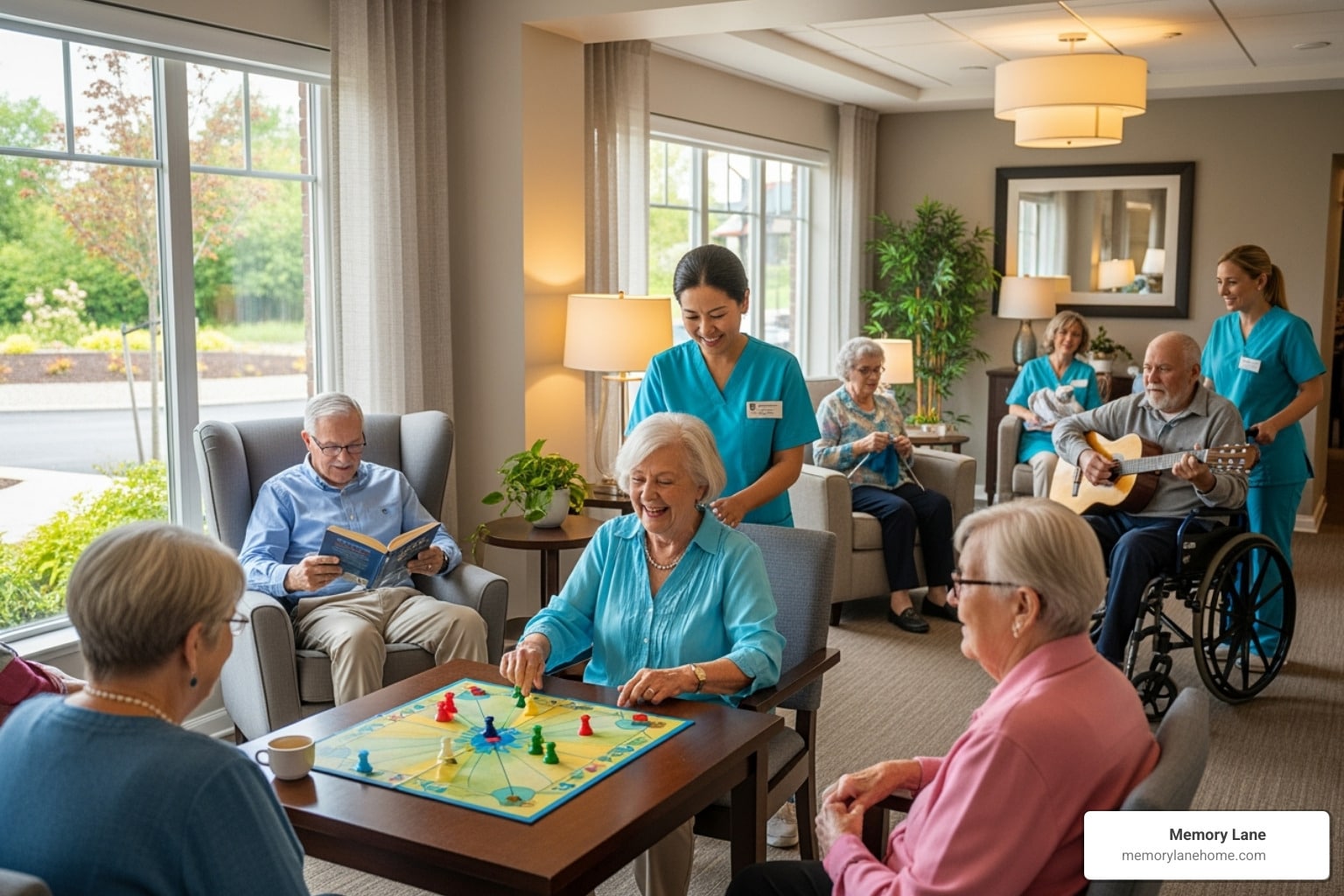Find the perfect assisted living Ypsilanti MI community in 5 simple steps. Explore needs, costs, tours, and make an informed decision today.

Assisted Living Support: What You Need to Know to Get Help
Assisted Living Support: Your 2025 Essential Guide
Why Understanding Assisted Living Support Matters for Your Family
Assisted living support provides housing, personal care services, and healthcare assistance for adults who can live independently but need help with daily activities like bathing, dressing, or medication management. Here’s what you need to know:
- What it is: A residential option combining private apartments with supportive services
- Who it helps: Seniors who need assistance with daily tasks but don’t require 24/7 medical care
- What’s included: Meals, housekeeping, personal care, medication management, social activities, and emergency response
- Average cost: $5,190 per month (varies by location and care level)
- Payment options: Private funds, long-term care insurance, veterans benefits, Medicaid waivers, and state programs
- Not covered by: Medicare (for room and board)
When a loved one struggles with daily tasks, you face a difficult decision. With about 70% of people over 65 needing long-term care, navigating the options can feel overwhelming. You want them to maintain independence and dignity while getting the support they need.
Assisted living offers a middle ground. It’s not a nursing home—it’s a home-like environment where residents live in their own apartments while receiving personalized help with daily activities. Communities provide 24-hour supervision, prepared meals, housekeeping, and social activities, all designed to help residents stay as independent as possible for as long as possible.
I’m Jason Setsuda, a Board Certified Emergency Medicine Physician and CFO of Memory Lane Assisted Living. With over 15 years in emergency medicine and senior care, I’ve seen how crucial proper assisted living support is for families navigating the transition to supportive care.

Understanding Assisted Living and Its Services
Assisted living support is the sweet spot between living independently and needing full-time medical care. In this residential setting, adults have private apartments but are never alone when they need help. They maintain their independence and routines, knowing assistance is always available.
Assisted living residences feel like home. Residents decorate their own spaces, come and go as they please, and maintain their routines. Unlike living alone, they have access to support services and a community of peers, offering life on their own terms with a safety net.
Assisted living isn’t a hospital or nursing home. It’s for people who don’t need intensive, round-the-clock medical care but may struggle with certain daily tasks. You won’t find ventilators or IV poles. Instead, you’ll find comfortable living spaces, communal dining rooms, and activity centers where residents can thrive.

What Services Are Typically Offered?
The heart of assisted living support lies in helping with activities of daily living—everyday tasks that become harder with age. Here’s what most communities offer.
Personal care is the foundation. Staff help residents with bathing, dressing, grooming, and moving around safely. Care is personalized to each person’s needs, always respecting their dignity and privacy.
Medication management is a lifesaver. Staff can remind residents when it’s time for medications or help administer them, depending on individual needs and state regulations.
Communities handle housekeeping and laundry, including weekly cleaning and fresh linens, so residents can focus on more enjoyable pursuits.
Meal preparation includes three daily nutritious meals served in a communal dining room, which doubles as a social hub. Communities accommodate special diets and can deliver meals to apartments.
24-hour supervision means trained staff are always on duty, and emergency call systems in each apartment ensure help arrives quickly. It’s peace of mind for residents and their families.
Social and recreational activities keep residents engaged and connected. From painting classes and gardening clubs to exercise programs and movie nights, these activities are vital for mental and physical health.
Transportation services keep residents connected to the wider community with scheduled trips for medical appointments, shopping, and outings.
While not providing extensive medical care, communities coordinate with residents’ outside doctors and healthcare providers to ensure everyone is on the same page about a resident’s health.
Who Is Assisted Living For?
Assisted living support is ideal for seniors who need daily help but can still make their own decisions. Perhaps they can’t shower safely but are mentally sharp, or they forget medications but are otherwise capable.
Younger adults with mobility challenges or other physical limitations can also benefit from assisted living. The key is that residents can protect themselves in an emergency and don’t need constant medical intervention.
Assisted living isn’t for anyone needing round-the-clock skilled nursing care, such as continuous medical treatment or ventilator support. In those cases, a skilled nursing facility is more appropriate. For more details, check out a guide to long-term care facilities from the National Institute on Aging.
The goal is to help people maintain their independence and dignity in a place that feels like home.
Navigating the Costs and Payment Options for Assisted Living
Understanding the financial side of assisted living support is crucial. The average stay is 2.5 to 3 years, so planning is essential.
The median monthly cost for assisted living is around $5,190, but costs can range from $3,655 to $8,036 or more. Specialized memory care—like the services at Memory Lane—can add an extra $800 to $1,200 per month, bringing the median to between $6,334 and $9,525.
Several factors influence cost. Location is a major one, with metropolitan areas costing more than smaller towns. The level and frequency of care also matter; more assistance means higher costs. Apartment size and amenities like upscale dining or fitness centers also affect the monthly rate.
Most assisted living communities operate on a private pay model, meaning families initially cover costs out-of-pocket.

Primary Private Payment Methods
For most families, personal funds are the foundation. Personal savings and investments—like CDs, stocks, and bonds—are typically the first resources used. Retirement accounts like 401(k)s and IRAs, along with regular pension payments, are also essential funding sources.
Selling the family home can generate substantial capital. With an average stay of 2.5 to 3 years at a median cost of $5,190 per month, the total investment is roughly $155,000 to $187,000. Home equity often makes this possible.
Some people explore life insurance policies with cash value, which can sometimes be accessed or sold. I always recommend consulting a financial advisor before making this complex decision.
Using Long-Term Care Insurance
Planning ahead pays off with long-term care insurance, which is designed to cover services like assisted living support. Unlike Medicare, it can cover custodial care and room and board.
These policies pay a daily or monthly benefit once you can’t perform a specific number of activities of daily living. Policies vary, with different benefit amounts, coverage periods, and elimination periods (the waiting time before benefits start).
The best time to buy long-term care insurance is in your 50s or early 60s when premiums are more affordable and you’re more likely to qualify. Waiting until you need care can make it prohibitively expensive or unobtainable. Premiums for qualified policies may also be eligible for an income tax deduction.
For more details, learn more about long-term care insurance from trusted resources.
How to Plan for Future Costs
The secret to managing assisted living costs is to start early. Don’t wait for a crisis to plan for senior care.
Begin by assessing potential care needs. A family history of dementia might suggest specialized memory care will be necessary, helping you estimate costs and timelines.
Next, create a comprehensive financial plan with an advisor who understands elder care. They can help evaluate all your assets—savings, investments, retirement accounts, insurance, and home equity—to develop a strategy. With an average stay of 2.5 to 3 years at a median cost of $5,190 per month, you’re planning for a significant investment.
Families who steer this transition most smoothly are those who start these conversations early and create a realistic financial roadmap.
Exploring Financial Assistance for Assisted Living Support
If affording assisted living support is a concern, you’re not alone. While most families pay out-of-pocket, assistance programs exist for those with limited incomes. The key is knowing what’s available in your state.

The Role of Medicaid
Medicaid is a joint federal-state program for Americans with limited incomes. For assisted living support, it can be a lifeline.
It’s important to know that federal law prohibits Medicaid from paying for room and board (rent, food) in assisted living. However, it can pay for care services like personal care assistance and medication management.
Most states achieve this through Home and Community-Based Services (HCBS) programs, which help people receive care in community settings rather than nursing homes. States use special Medicaid waivers—1915(c) or 1115 waivers—to cover services that standard Medicaid doesn’t. Currently, 41 of 47 responding states cover home care services in assisted living through at least one Medicaid program.
About one in five assisted living residents—roughly 200,000 people—have their daily care services covered by Medicaid. To qualify, you must meet state-specific financial and functional need requirements. An overview of state Medicaid plans and waivers can help you understand what’s available where you live.
Low-Income Options for Assisted Living Support
For seniors with limited resources, several programs can make assisted living support more accessible.
Supplemental Security Income (SSI) provides monthly cash benefits to aged, blind, and disabled individuals with limited income. While not enough to cover all costs, it provides a foundation. Some states offer supplemental SSI programs for assisted living residents.
Many states have their own subsidy programs. For example, Indiana has the Residential Care Assistance Program and Maryland has the Assisted Living Program. In total, 44 states and D.C. offer some financial aid. Programs vary, so check with your local Area Agency on Aging for resources.
HUD housing programs can also help. The Section 202 and Section 811 programs help develop housing for very low-income seniors and adults with disabilities. The Housing Choice Voucher Program (Section 8) can help cover housing costs, making the overall expense more manageable.
Veterans and their surviving spouses may qualify for the Aid & Attendance benefit, providing up to $2,200 monthly for a veteran with a spouse. Surprisingly, fewer than 5% of eligible veterans use this benefit. Visit the VA Aid and Attendance benefits page to see if you qualify.
More affordable alternatives include aging at home with support from services like Meals on Wheels, living with family, or residential care homes (smaller, licensed facilities that may have lower costs).
Eligibility for many programs depends on income. Generally, an individual with an annual income below $23,475 is considered low-income, but this varies. Your local Area Agency on Aging can help determine eligibility and guide you through applications.
Resident Protections and Finding Help
Choosing an assisted living support community is a major decision. It’s vital to be informed about the services, costs, and the rights that protect residents.
Understanding Your Options for Assisted Living Support
One of the most common concerns is what happens when private funds run low and Medicaid becomes necessary.
Federal law offers safeguards for residents transitioning to Medicaid. Under the HCBS Settings Rule, facilities accepting Medicaid must provide protections similar to landlord-tenant law, including rights regarding eviction notices and appeals.
The specifics vary by state. Twenty-five states offer extra eviction protections, such as requiring facilities to help with relocation or capping fees. However, only 10 states require facilities to accept new Medicaid residents. Some, like New Jersey and Oklahoma, mandate all facilities to accept Medicaid enrollees.
This is why you must ask about a facility’s Medicaid acceptance policy before signing any agreement. This single question can prevent future stress. You can find more information on resident eviction protections to understand your state’s rules.
Every facility should provide a Disclosure of Rights and Services document. Read it carefully and ask questions if anything is unclear. A quality facility will provide straightforward answers.
When concerns arise, the Long-Term Care Ombudsman is a powerful advocate. Every state has an Ombudsman program to help residents with issues related to care quality, rights, or evictions at no cost. You can find the Long-Term Care Ombudsman contact number for your area through the National Consumer Voice for Quality Long-Term Care.
Protecting residents from abuse, neglect, and financial exploitation is critical. If you suspect immediate danger, call law enforcement. For other concerns, contact your local Adult Protective Services (APS) agency, which investigates reports for long-term care facilities. You can find the APS reporting number for your area through the National Adult Protective Services Association.
Financial exploitation is another serious concern. Stay informed about common scams by using resources from the Consumer Financial Protection Bureau (CFPB) and the Federal Trade Commission (FTC) to help protect your loved ones.
Frequently Asked Questions about Assisted Living
Throughout my years working with families navigating assisted living support, I’ve heard the same questions come up time and again. These concerns are completely natural. Let me address the most common ones.
What is the difference between assisted living and memory care?
Assisted living is a residential community where seniors get help with daily activities like bathing, dressing, and medication management. Residents live independently in their own apartments while participating in community life. It’s for those who need daily assistance but not intensive medical care.
Memory care takes assisted living support a step further for individuals with Alzheimer’s, dementia, or other cognitive impairments. It features secure spaces to prevent wandering, specially trained staff, and structured routines.
Memory care activities are custom to residents’ cognitive abilities, focusing on their strengths to preserve identity and dignity. At Memory Lane, we provide this specialized 24/7 personalized care, with custom plans and engaging activities in a secure, compassionate environment.
What happens if a resident runs out of money?
This is a common and understandable fear. If private funds are depleted, a resident may transition to Medicaid if they meet eligibility requirements. It is crucial to choose a facility that accepts Medicaid payments from the start. Otherwise, your loved one may be forced to move, which can be incredibly difficult.
Some states have protections against eviction when residents transition to Medicaid. These vary, so it’s important to ask about a facility’s Medicaid policy and what happens if a resident’s financial situation changes before you sign an agreement.
How do I find a quality assisted living community?
Finding the right assisted living support community requires both research and intuition. Here’s a thoughtful approach to your search.
Start by gathering recommendations from your doctor, social workers, clergy, or friends. Your local Area Agency on Aging or Long-Term Care Ombudsman can also provide objective information.
Visit multiple communities at different times of day. Drop by during a meal or an activity to observe the environment and resident engagement.
Ask the questions that matter most. Inquire about staffing ratios (especially at night), staff training, emergency procedures, and how care plans are personalized and updated.
Talk to people who live there. If possible, chat with current residents and their families to get an unfiltered perspective on daily life, care, and communication.
Review official documentation. Request state licensing reports and read online reviews. Carefully review the residency agreement, as it is a legal contract outlining costs, services, and rights.
Use a systematic approach. A checklist covering cleanliness, activities, staff responsiveness, and safety can help you make objective comparisons.
The goal is to find the right fit for your loved one’s personality and needs—a place that provides excellent care while honoring their dignity and independence.
Conclusion
Finding the right assisted living support can feel overwhelming, but you’re not alone. This guide has covered the essentials: what assisted living is, its services, costs, and the financial assistance programs available.
Planning ahead is key. Exploring long-term care insurance, researching Medicaid waivers, or having honest family conversations early on creates more options later. With an average stay of 2.5 to 3 years at a median cost over $5,000 per month, a financial strategy is essential.
Multiple support options exist. From Medicaid waivers and veterans’ benefits to HUD housing and state subsidies, financial help is available. The key is understanding your eligibility and choosing a community that accepts these payment methods before a crisis arises.
Your loved one deserves care that honors their dignity and promotes their independence. The resident protections we discussed, from eviction safeguards to the Long-Term Care Ombudsman, exist to ensure they receive it. Take your time visiting communities, ask the hard questions, and trust your instincts.
At Memory Lane, we understand the unique challenges families face when a loved one lives with dementia or Alzheimer’s. Our communities in Ann Arbor, Ypsilanti, and Saline, Michigan, provide specialized memory care and assisted living support with 24/7 personalized attention. We create custom care plans, offer engaging activities, and maintain a secure environment where residents can thrive.
Taking the next step starts with a conversation. We invite you to explore our memory care and assisted living services for compassionate support and find how we can help your family find the peace of mind you deserve.


